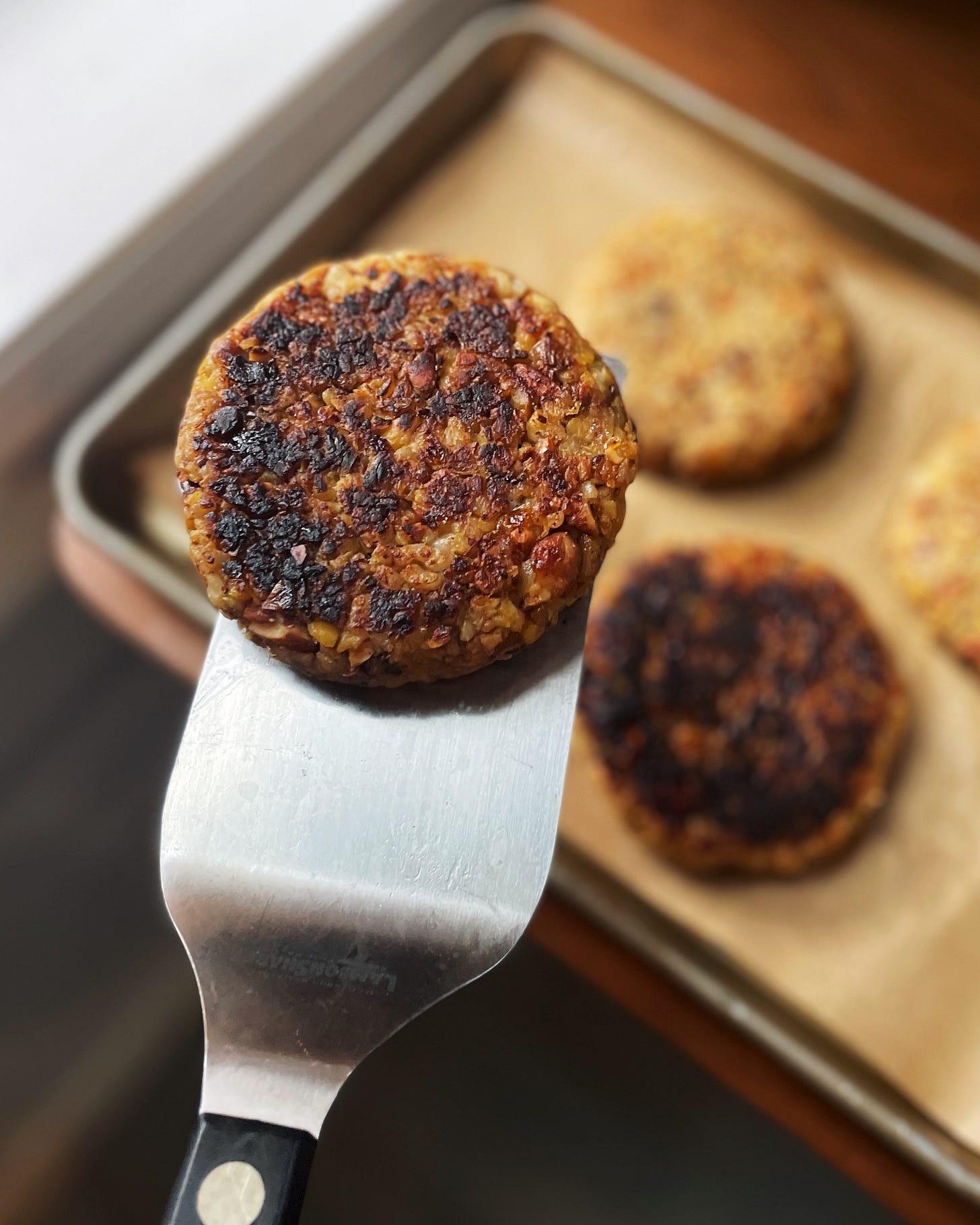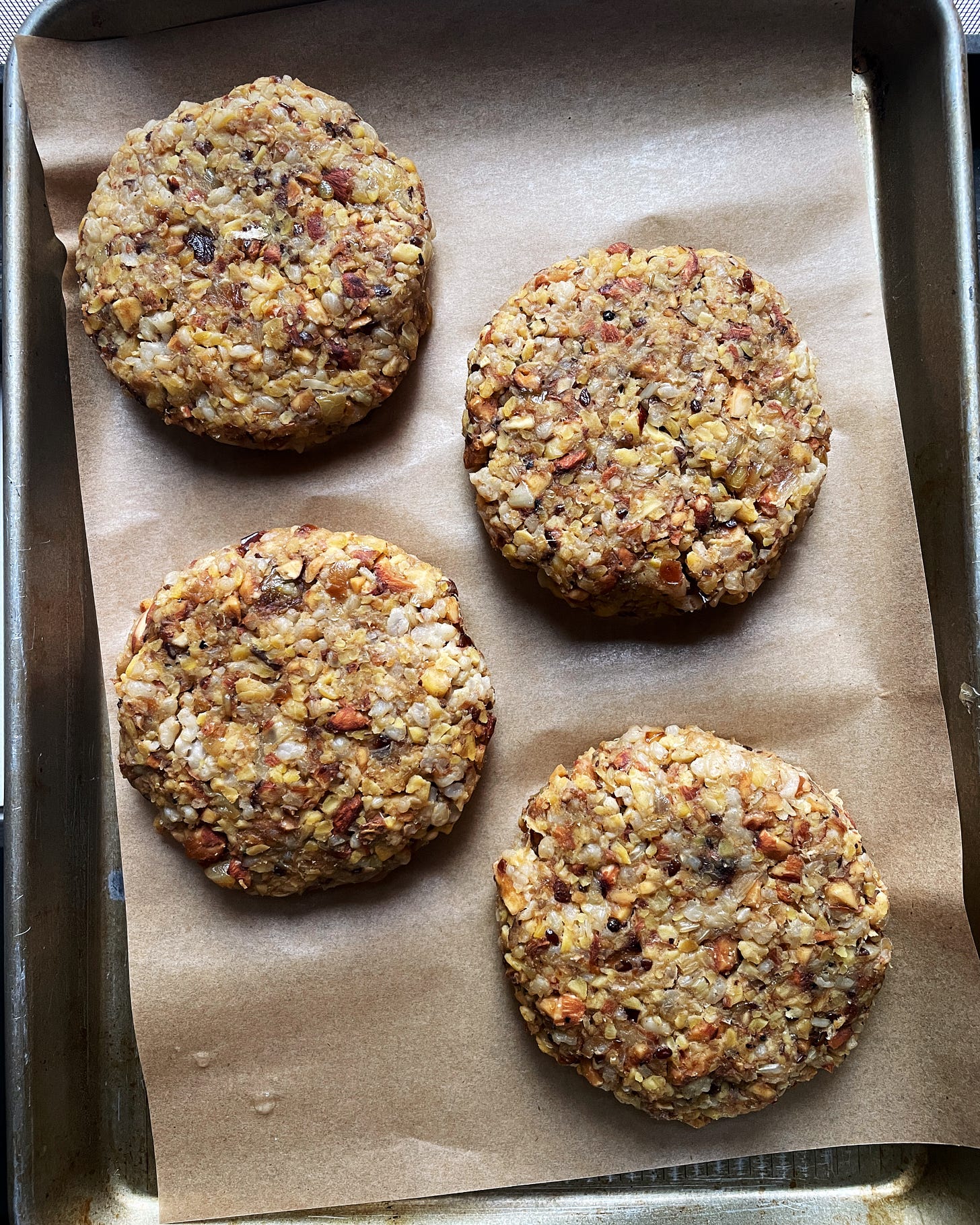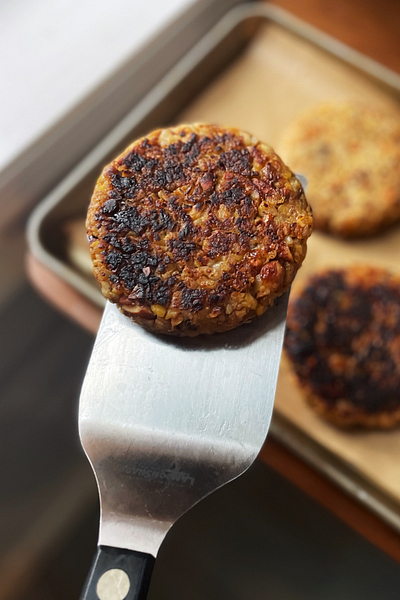Time for Tempeh
I'm finally embracing this powerhouse protein full-on, starting with these Sweet-Savory Tempeh Veggie Burgers
Welcome to Part 3 in my 6-week series focusing on protein! If you missed the first post (free for all), I explain some of the inspiration and reasoning behind the series there. In the second post (for paid subscribers), we delved into breakfast.
Tempeh is a plant-based protein that I’ve only slowly, maybe reluctantly, embraced. I’ve certainly been aware of (and enticed by) its many culinary uses and nutritional advantages, and I’ve loved learning about its prominent place in Indonesian cuisine through books by James Oseland and Lara Lee. I’ve even worked with tempeh a bit in the past, such as the two tempeh burgers in Veggie Burgers Every Which Way.
But something about how it’s a bit harder to find than tofu, and how it’s got a more pronounced, less versatile flavor, has kept me a little bit at bay. It just hasn’t ever been a regular item in my shopping cart.
This year it’s time to change that. In fact, I just ordered my own tempeh starter so that I can try making tempeh from scratch at home! I will try to document the process.
Below is a quick overview of tempeh — its interesting history, production process, nutritional profile, and some notes on how to cook with it. Much of the historical and nutritional information comes from Kirsten and Christopher Shockey’s excellent and very thorough book Miso, Tempeh, Natto & Other Tasty Ferments.
And then you’ll find an exciting, easy new recipe where tempeh takes center stage in a veggie burger alongside an assortment of punchy sweet and savory flavors.
Tempeh History
Tempeh (also spelled tempe) most likely originated in Java, Indonesia, and is believed that it came to be via the transfer of fermentation techniques with one of its koji- and soy-loving neighbors like Japan or China.
The Javanese word for soy, kedele, shows up in the 13th century, which suggests that tempeh has been under development since sometime around then. Others place it later, with the early 19th century court poem Serat Centhini in which tempeh first appears in writing with the mention of two specific dishes.
The warm climate of Java and its neighboring Indonesian islands have ideal circumstances for tempeh’s fast fermentation, and it is an immensely popular protein throughout the region.
How It’s Made
Soybeans are the most common “substrate” used to make tempeh, but it can be made from other legumes, seeds, and grains, too. The hulled, soaked, and partially cooked beans are combined with a starter — made of rhizopus spores, found readily in soil and plant material (it’d been found on the undersides of unwashed hibiscus leaves way back) — to inoculate.
Once inoculated, the beans are wrapped in little parcels that allow a bit of air in, such as in banana or teak leaves, or (the case in most commercial processes) in perforated plastic bags. A web of white spores develops around them, binding the beans into a dense cake.
This all happens in about three days.
Refrigerated, store-bought tempeh is then pasteurized and shrink wrapped, which makes it more shelf stable. But there are also many small-batch tempeh producers throughout the United States who sell unpasteurized tempeh, typically keeping it in the freezer. Barry’s Tempeh is one such producer here in the NYC region where I live. The fresh, unpasteurized kind has a fuller flavor and softer texture — it’s worth seeking out!
Incredible Nutrition & Flavor
Some call tempeh a superfood, and it’s hard to argue with that. Tempeh is…
High in protein, containing roughly the same amount as beef at 31 grams per cup, cubed
High in fiber, with 14 grams per cup, cubed
It’s also a great source of vitamin B12, calcium, magnesium, and antioxidants
Tempeh is also extremely digestible, particularly compared to normal cooked beans. The enzymes that break down the substrate during fermentation are the same enzymes present in our bodies — this means (and sorry if this sounds a little gross) that tempeh is essentially pre-digested!
It has a dense, nubby texture that takes well to searing and deep-frying, because it can get nice and crispy all over. Its flavor is nutty, earthy, and a little sour. It’s sometimes recommended to steam tempeh before frying or baking it, which can awaken its flavors and soften any bitter notes. I don’t always steam it; it’s up to you.
Recipes & Cooking Tips
As with people still warming up to tofu, my advice is to frame it in its proper context — in this case, a balmy, tropical Pacific climate. Tempeh takes brilliantly to bold, bright flavors like hot peppers; sticky and sour sauces; heady, spicy, and floral aromatics. It’s a sturdy ingredient; it doesn’t need to be handled delicately.
In Western vegan and vegetarian recipes, you probably already know tempeh as a popular meat substitute — for decades it’s been used as vegan bacon for sandwiches or ground meat as in crumbles. But here are a few other recipes and approaches to consider…
Stir-Fried Sliced Tempeh, from Cook Me Indonesian
Orange Pan-Glazed Tempeh, from 101Cookbooks
Tempeh Penyet (Smashed Tempeh with Sambal), from the New York Times (gift link)
And then there’s these veggie burgers.
I wanted to embrace the full flavored, sweet and savory aspects of many traditional tempeh treatments, so I’ve packed them with dates, which offer sweetness and some help binding, as well as a good dose of fresh ginger, garlic, and soy sauce. They have a delightful, distinctive flavor profile and are really a one-of-a-kind veggie burger. They also have an ideal texture that’s sturdy and very satisfying.
I’ve included more cooking notes with the recipe below.
Are you into tempeh? What’s your favorite recipe or technique?
Sweet-Savory Tempeh Burgers
Lightlife seems to be the easiest brand to find near where I live. If you can find a locally made, fresh one — usually sold in the freezer section or by buying directly from the producer — it will have a softer texture and better flavor.
Precooked rice or grain packets can help streamline things here, if you don’t have leftover cooked rice on hand.
Walnuts, cashews, or hulled sunflower seeds can be substituted for the almonds.
For additional protein and a higher yield, add a 14.5-ounce can of chickpeas along with the tempeh, though be aware that this dilutes the flavors and produces a slightly wetter mixture.
Increase the protein by serving these burgers over salads with high-protein veggies and legumes, like fresh spinach, chickpeas or other beans, roasted brussels sprouts, cubes of sweet potato, avocado wedges, or fresh or roasted mushrooms — or even a scoop of cottage cheese or a boiled egg.
Protein: 18 grams per serving
Yield 4 burgers or 12 sliders | Prep & Cook time About 25 minutes, not including resting time
Olive oil
1 medium white or yellow onion, diced
2 or 3 cloves garlic, sliced
½ teaspoon fine salt
1 heaping tablespoon freshly grated ginger
¼ to ½ teaspoon dried chili flakes
1 tablespoon apple cider vinegar
2 teaspoons tamari or soy sauce
5 dates, pitted and coarsely chopped
One 8-ounce package tempeh, cubed
¾ cup (105g) almonds
⅔ cup (120g) cooked short-grain brown rice, or other chewy grain
2 teaspoons arrowroot or cornstarch
1. Warm a medium skillet over medium heat and when hot, swirl in a thin film of olive oil. Add the onions, sliced garlic, and salt, and cook until the onions are golden brown and sweet, 10 to 15 minutes. Stir in the ginger and chili flakes and once fragrant, the apple cider vinegar and soy sauce. Stir in the dates and tempeh, cook for 2 or 3 minutes more, then remove from the heat. Cool for about 5 minutes.
2. Scrape the tempeh mixture into a food processor with the almonds, rice, and arrowroot. Make one-second-long pulses until the mixture coheres into a chunky, evenly combined mass (if it’s slow to combine, knead the mixture by hand to incorporate the ingredients rather than over-processing it in the food processor; aim to keep plenty of texture). Shape into 4 patties or 12 sliders and refrigerate them, covered with food wrap, for at least an hour to firm up.
3. To cook, rinse out the skillet and set it over medium-low heat. Once hot, swirl in a thin film of olive oil and add as many burgers or sliders as will fit comfortably without crowding. Cook until golden brown, then flip and repeat on the other side, until browned and heated through, 4 to 6 minutes per side. Serve between burger buns or on top of salads.





I made it tonight, it’s the best tempeh recipe ever. We all loved it and I’ll be making it again next week! Thank you for sharing.
Thank you for sharing your talent w Tempeh. I’ve been hunting for a good intro for a while.